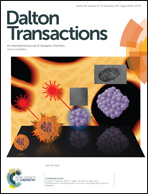Temperature-dependent photoluminescence of cadmium-free Cu–Zn–In–S quantum dot thin films as temperature probes†
Abstract
We reported temperature-dependent photoluminescence (PL) studies on Cu–Zn–In–S quantum dot (QD) thin films. In this paper, cadmium-free and luminescent Cu–Zn–In–S quantum dot thin films were in situ formed by thermal decomposition of molecular-based precursors in the open air, without need of the complicated quantum dot synthesis. Molecular-based precursor solutions were prepared by dissolving Cu2O, ZnO, and In(OH)3 in the ethanol solution of butylamine and carbon disulfide. The effects of sintering temperature, sintering time, and the concentration of capping agents on the photoluminescence properties of Cu–Zn–In–S QD thin films have been systematically investigated. It was found that alkali metal ions play an important role in enhancing the PL quantum yield of quantum dot thin films. The as-prepared QD thin films show composition-tunable emission in the range of 535 nm to 677 nm, and the absolute PL quantum yields can reach as high as 22.1%. All of the as-deposited QD thin films show a single-exponential decay to temperature, indicating that these cadmium-free QD thin films have high potential as temperature probes.


 Please wait while we load your content...
Please wait while we load your content...